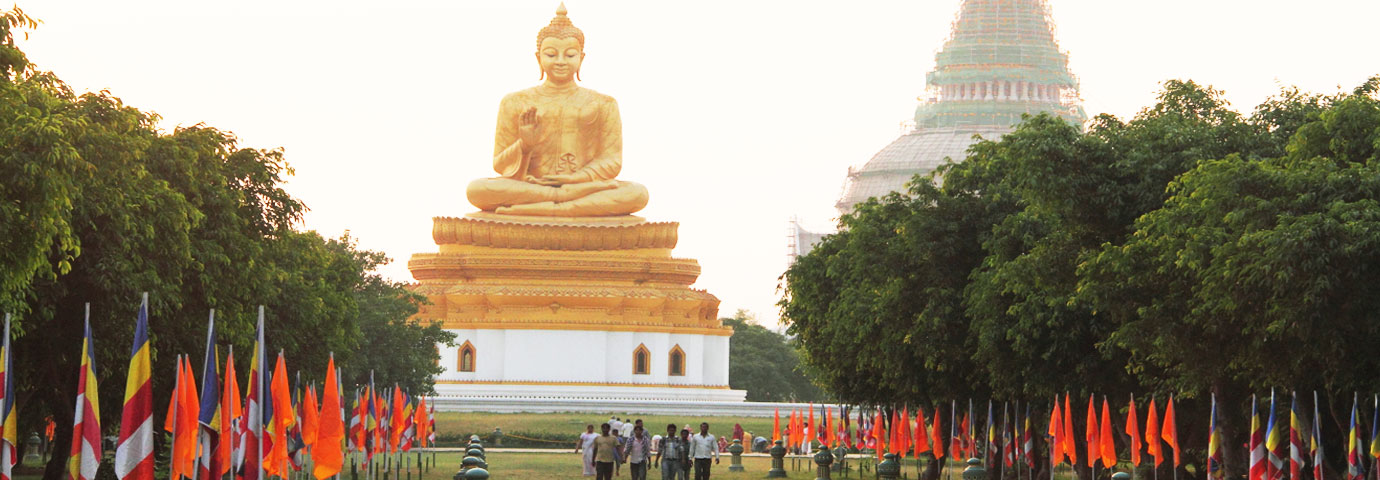Location
Sravasti is situated in the north Indian state of Uttar Pradesh around 176 km off Lucknow. It is a part of the Buddhist circuit that encompasses the states of Uttar Pradesh, Bihar, and Nepal. There are good rail and road networks that connect this small place with the other places in the region.
Best Time To Visit
Sravasti, due to its location in the Gangatic plains and proximity to the Tropic of Cancer, enjoys a comfortable winter but a really hot summer. In the winters, the night temperature can go down to around 10°C and the day temperature to 20°C. October-November and February-March are almost always comfortable and sunny. Begining in April and continuing through June, it is extremely dry and the daytime temperature often reaches 45°C. In late June or early July, monsoon season brings torential rains and high humidity.
History
During the time of Sakyamuni, a rich and pious merchant named Sudatta lived in Sravasti. While on a visit to Rajgir, he heard the Buddha's sermon and decided to become the Lord's disciple. But he was caught in a dilemma and asked the Lord whether he could become a follower without forsaking worldly life. To his query, the Buddha replied that it was enough that he followed his vocation in a righteous manner.
Sudatta invited the Buddha to Sravasti and began to look for a suitable place to build a vihara. A beautiful park at the southern edge of Sravasti attracted his attention. The park belonged to Jeta, son of King Prasenjit of Sravasti. Jeta demanded that Sudatta cover the entire park with gold coins. Sudatta painstakingly paved every inch of the land with gold. Then Jeta said that since the trees were left uncovered they belonged to him. But finally, he had a change of heart and donated valuable wood to build the vihara. The park came to be known as Jetavana Vihara in recognition of Prince Jeta's donation to the sangh.
Buddha spent 25 years living in the monastery of Jetavana. Many Vinaya rules, Jatakas and Sutras were first discussed at this place. The Buddha is supposed to have astonished rival teachers by performing miracles at Sravasti. It is said that it was in Sravasti that the Buddha transformed Angulimal from a dacoit into a Buddhist monk. He also delivered many important sermons here. King Ashoka erected two pillars 21 meters high on either side of the eastern gateway of the Jetavana monastery. Sravasti was a flourishing center of learning during the Gupta period. When the famed Chinese traveler Hiuen Tsang visited this site, he found several damaged stupas and ruins of monasteries and a palace.
Tourists Attractions
Sravasti has two villages, Sahet and Mahet. From the Balrampur-Sravasti road one can enter Sahet, which is spread over an area of 400 acres and has a number of ruins. A little north of Sahet, towards the Rapti River, is the ancient fortified city of Mahet. The entrance to the mud fortification of Mahet is constructed in a beautiful crescent shape. Though an ancient structure, its five gates and walls are still visible. Pakki Kuti, Kuchhi Kuti and many other stupas tell the story of the great monasteries that once stood here.
Remnants of Jetavana, a splendid monastery with inscriptions dating back to the 12th century, is thought to be one of the favourite sites of the Buddha. Emperor Ashoka is also said to have visited this site. There is a sacred pipal tree here, which is a sapling from the original Maha Bodhi tree under which the Buddha had attained nirvana. Today, Jetavana has two monasteries, six temples and five stupas. One temple was built by the monk Ananthapindika and called Gandhakuti. This is the most sacred temple in Jetavana since the Buddha is believed to have lived at this spot.
Sravasti was also under the influence of Lord Mahavira the last Jain Tirthankar, and the splendid Shwetambara temple here attracts thousands of Jain pilgrims. The Sobhnath Temple is believed to the birthplace of the Jain Tirthankar Sambhavnath.
Places Around Sravasti
The Devi Patan Temple is located some 28 km from Sravasti. It is one of the most important Shaktipeeths in the region, revered by Hindus in India and Nepal.Sankissa is the place where the Buddha descended from heaven along with Lord Brahma and Devaraj Indra after giving a discourse to his mother, Mayadevi who had died soon after giving birth to him. Emperor Ashoka erected a pillar with an elephant capital to mark this holy spot. Sankissa is situated on the banks of river Kali and is most easily accessible from Agra, which is 175 km away. The nearest railhead is Pakhna, 11.5 km away.
How To Reach
By Air - The nearest airport from Sravasti is Lucknow, 176 km away. One can take flights for other cities of India such as Delhi, Mumbai, and Varanasi from Lucknow.
By Rail - The nearest railway station from Sravasti is Gainjahwa, on the Gonda-Naugarh-Gorakhpur loop line. Gonda and Gorakhpur are connected to the other cities in India through a fairly good number of trains.
By Road - Sravasti is connected with Gonda, Gorakhpur, Lucknow and other cities in central Uttar Pradesh through state transport corporation buses. The nearest large town from Sravasti is Balrampur some 20 km away.


